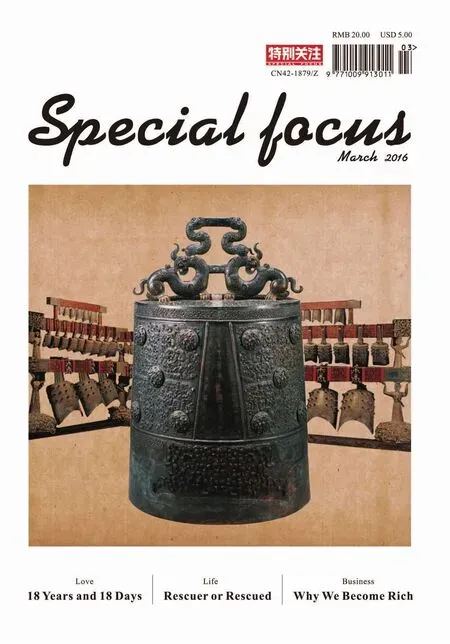Hubei Elements Shining Along the New Silk Road
By Gan Yong
Hubei Elements Shining Along the New Silk Road
By Gan Yong
T he New Silk Road economic belt covers some of the grandest and most spectacular sceneries on the planet.
The land route begins way out west in Xi’an following camel bells ringing through the air all the way to Europe;the sea route sets off from the southeastern coast,following the stars and crossing the ocean,finally reaching the shores of the Atlantic through the Malacca Strait.
With a history spanning thousands of years,the two Silk Road routes now flourish with new momentum.From the Chu Mountain and the Han River to the hinterland of Eurasia,from the surging Yangtze River to the vast expense of the ocean,the province of Hubei joins in the grand,national initiative of“the Belt and Road”as it opens its arms to embrace the world.
New Silk Road,New Dream
It’s been said,“To understand the present,we must first know the past.”
On the blue flagstones of the Ming and Qing dynasties ancient streets in Yangloudong at the junction of the three provinces of Hunan,Hubei and Jiangxi lies the rut of a wagon trail etched into the sand marking the starting point of the ancient Sino-Russian tea trade route of the 17th century.The Chinese tea was shipped out from Yangloudong,sent on the waterway of the Yangtze River to Hankou and went against the current of the Han River to Xiangyang,where it was put on the land route on mule, horse,and camel caravans.Then,on past the Yellow River,Baotou and Mongolia,whereiteventuallyreached Kyakhta and was sold in Moscow,Saint Petersburg and the rest of Europe.
Another ancient Silk Road route was even less known.The silk fabrics of the state of Chu in the Pre-Qin era were exported to regions of Myanmar and India via Yunnan through the southwest waterway.This“Chu-India Trade Route”became China’s earliest Silk Road.
At the second meeting of the regional leaders of China and Russia,the Chinese party presented the Russian side with Yangloudong“The Sino-Russian Tea Route”black brick tea designed and specially produced in Hubei.At the Hubei Tea Appreciation Meeting held in Almaty,Kazakhstan,the mellow Hubei black brick tea won the favor of all the tea drinkers in attendance.The Yangloudong Company signed the partnership agreements with the local firms. And Hubei tea thus made an overall come back in Russian and Central Asian markets.
Today,the New Silk Road is lifting Hubei out of the doldrums her peers are facinginforeigntrade.Hubeihas achieved 12.08 billion yuan through bilateral trade with 32 countries along the maritime Silk Road,with 30.8%growth year-on-year.With 47 countries along the land Silk Road economic belt,Hubei has also realized bilateral trade of 6.99 billion yuan,with a yearly increase of 19.1%.Both have exceeded the overall foreign trade growth rate of the whole province.
New Passage,New Opportunities
“Those with the same ambitions fear not high mountains and distant seas”.The New Silk Road has overcome the high mountains and the distant seas.
Wuhan-Xinjiang-Europe,the Sino-European international freight train known as“Han-Xin-Europe”for short,built a bridge for central China,specially open-ing up Hubei to the west.The Silk Road goes straight through the riverside city, accelerating Wuhan’s transition into a global freight transit centre.

On April 23,2014,the first regular train of“Wuhan-Xinjiang-Europe”set off from Wujiashan of Wuhan and headed forHamburg,Germanythrough Kazakhstan,Russia,Belarus,Poland and the Czech Republic.In just over a year, the Wuhan-Xinjiang-Europe lines have been dispatched 77 times,35 of which were block train freights and 42 fragmented,with 3,304 standard containers shipped to the other end of Eurasia.
Hubei has opened the new passage to the outside world.
With the leveraging of the golden waterway,the Maritime Silk Road also set sail.
The Yangluo Port of Wuhan has opened the testing route from Wuhan to the four ASEAN countries(Thailand, Cambodia,Vietnam,Laos).By taking thefourportsofYangluo,Wuhan; Waigaoqiao,Shanghai;Bangkok,Thailand;and Ho Chi Minh,Vietnam as the transportation nodes,and with a weekly double-shift transport,the great channel to“the 21st Century Maritime Silk Road”is open.
Meanwhile,the air corridor is getting more intensive and more rapid.
At present,with 34 national and regional routes,Hubei has initially formed an international airline network linking to the surrounding areas,directly accessing Russia and radiating to North America.Wuhan has become the first 72-hour Transit Without Visa city in central China.
New Ideas,New Transition
“Helping others is to help oneself.Establishing others is to establish oneself”. By leveraging“the Belt and Road”initiative,Hubei develops right alongside its trade partners.
The Hubei Seed Group is the“pioneer”in entering the New Silk Road. Since 1999,it has explored the Southeast Asia market in Bangladesh,Pakistan and other countries.At its peak,the Hubei Seed Group took 51%of the market share of imported rice seeds in Bangladesh.By utilizing local resources, they have developed new crop varieties of high quality,high yield and multiple resistances suitable for Pakistan.
“Where there is bread,there is Angel Yeast”.In a trade event in 1996,the doors to trade between Angel Yeast and Central Asian countries were open.

Xinjiang,with an annual production capacity of molasses of about 250,000 tons,abounds in raw materials and resources such as coal,water,electricity and so on,which can reduce the cost of yeast production.In 2004,Angel Yeast (Yili)Co.,Ltd.began construction.And its formal production started 11 months later.Today,the Angel Yili Company produces 25,000 tons of yeast and 8,000 tons of yeast extract products every year and is the second largest yeast plant in China.
Now,a group of Hubei enterprises are enjoying a good reputation along the New Silk Road.
The large-scale aircraft manufacturing plant,the seven-star Centaurus Hotel Islamabad,most of Pakistan's landmark buildings were built by the China Construction Third Engineering Bureau Co., Ltd.
Pakistan's largest hydroelectric dam was constructed by the Gezhouba Group.
The key node of the Trans-Asian Railwayproject,Bangladesh'sPadma Bridge,is being built by China Zhongtie Major Bridge Engineering Group Co., Ltd.After this"dream bridge"is built and open to traffic,it will drive up the annual GDP growth of Bangladesh by 1. 2%.
Bringingwiththemtechnology, friendship and a win-win scenario,this batch of Hubei overseas enterprises are a window for Hubei going global.
The global layout is undergoing profound and complex changes.In moving forward hand in hand along the journey on“the Belt and Road”and carrying with them a common dream,Hubei is writing a new and momentous chapter.
(FromHubei Daily.Translation:Trans.)

